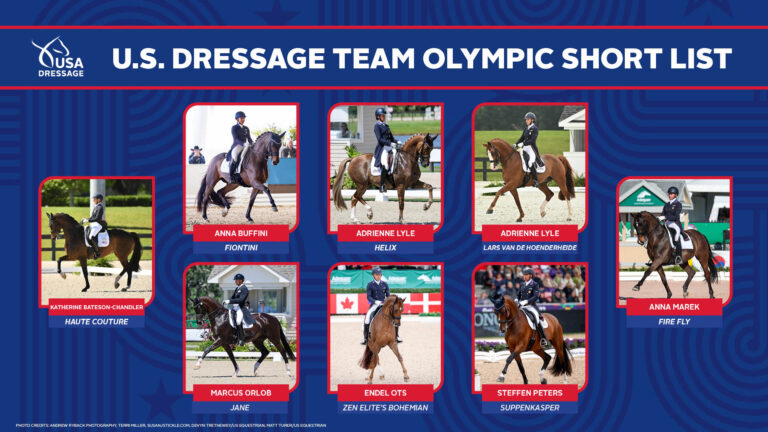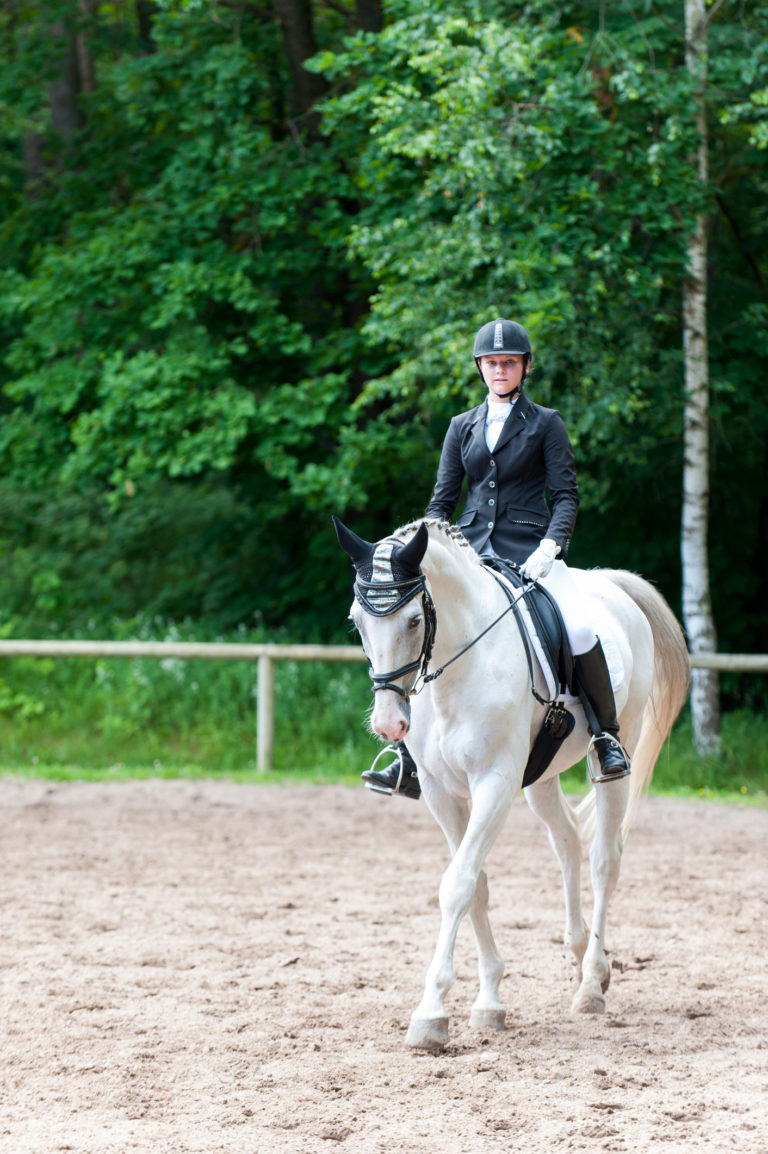Q: When I ride überstreichen, my horse doesn’t stretch his neck forward. His head and neck remain more or less in the same spot. I thought that he should follow the reins and stretch his neck out. Should his frame change at all? What should my hands exactly do? What is the purpose of überstreichen, and when do I use it?
—Sarah Leachman of
Redmond, Oregon
A: Literally translated from the German, “über” means “over” and “streichen” means “to stroke or pet.” Put simply, überstreichen is a slacking of the reins by moving both hands forward along the horse’s neck for several strides, demonstrating that the horse is in self-carriage. During this release, the tempo, balance and outline of the horse should not change. It can also be a test of diagonal connection (inside leg to outside rein) and bend by releasing just the inside rein for several strides while riding on a curved line, the goal being that the bend and balance remain the same during the release. In both cases, the reins are softly taken back up afterward.

As an Amazon Associate, Dressage Today may earn an affiliate commission when you buy through links on our site. Product links are selected by Dressage Today editors.
Überstreichen differs from the exercise “allowing the horse to chew the reins forward and downward,” which involves opening the fingers and encouraging the horse to lower and stretch his neck out into the bit.
Both exercises are important in dressage training, and I encourage you to make frequent use of them in every training session. While the former helps to increase balance, confidence and collection, the latter improves your horse’s physical and mental relaxation.
DT Editor’s Note: To learn more about the German system of dressage training, check out the following books!
The Principles of Riding: Basic Training for Horse and Rider by the German National Equestrian Federation
Advanced Techniques of Dressage: An Official Instruction Handbook of the German National Equestrian Federation
You can use überstreichen to test not only your horse’s longitudinal balance, but also his straightness and confidence as well as your own balance, symmetry and independent use of the aids. For example, if during überstreichen, your horse falls onto the forehand and/or changes the rhythm or tempo, it tells you that he was not properly balanced before the release. Perhaps your horse lacks engagement or activity or he pushes the hind legs out behind, or you habitually hold him together with the reins. Any of these problems can cause loss of balance and indicate that your basic work needs improvement.
If your horse drifts to one side or assumes a crooked position during überstreichen, it tells you that you need to improve straightness by aligning his shoulders and hips, which in itself will improve the balance and allow the horse to come more through from behind.
If your horse stiffens or hollows his back during überstreichen, it shows you that you may not have him correctly connected from back to front—directed from an effective seat and leg toward a soft receiving hand. It can also mean that you need to improve the quality of your half halts when applied before the release.
Half halts serve to improve the horse’s balance and act as a call to attention, preparing him for upcoming turns, figures, changes of gait, etc. To perform a half halt, grow taller in the saddle by firming your middle position, or core. Lightly close your legs or activate them a bit more if necessary, and close your fingers around the reins. Then immediately relax your aids, which is the final phase of the half halt. The entire action lasts but a few seconds. If you use your aids in the right proportion and with a timely release, your horse’s balance momentarily shifts toward his hindquarters. If, however, your half halt lacks forward intent or you dominate with your hands or sustain the aids too long, it will have the opposite effect of hollowing the horse’s back and disengaging the hind legs.
Half halts take time and practice to master. That being said, it is not necessary to ride a half halt each time before performing überstreichen, especially if you feel that your horse is already in self-carriage. Use the half halt simply as further proof of your horse’s balance and/or to reward him.
Überstreichen is an excellent opportunity to test your own body balance and symmetry in the saddle. It encourages an independent seat and often cures riders who habitually hang on the reins for support. During the release, are you able to continue to sit in the middle of the saddle with long, relaxed, draped legs, a supple lower back and hips, elongated upper body and stable torso? The release may create more confidence in you by encouraging body balance as well as move the focus from the horse’s mouth to the feeling of his body swinging underneath you. This can be life-changing for some riders.
Additionally, überstreichen is a wonderful tool to increase confidence in the horse. Even a younger horse can benefit, although it is typically used for horses that are further along in their training and already have a concept of self-carriage. Generally, horses dislike being out of balance because it results in stress and tension. At liberty, horses are well-balanced on their own, but when we add the weight of the rider, this balance changes and poses difficulties for the horse. The rider’s job, through correct and systematic development of the horse’s muscles and mind, is to not only re-establish the horse’s balance under saddle, but also to improve it, thus lightening the forehand over time. Überstreichen, when included in the training program, gives the horse momentary rewards where he can carry his rider in balance, which in turn instills confidence. A balanced horse is a happy horse, in tune with his rider.
When should you use überstreichen? The answer is often. Good, conscien- tious riding employs countless transitions and überstreichen may be used in conjunction with them. For example, use it after half halts to check their effectiveness; after downward transitions, such as from medium trot or canter back to collection; after transitions within a gait, such as from collected canter to very collected canter or from collected trot to half steps; during extremely collected exercises, such as piaffe or canter pirouettes; anytime you want to test your horse’s balance or when you wish to reward him for achieving it.
In essence, überstreichen is a wonderful tool, giving you valuable feedback and improving communication and harmony. Use it often and enjoy the results.
Click here to read more articles with Sandy Hotz.

Sandra Hotz
is a U.S. Equestrian Federation “S” judge and has been judging since 1989. She has ridden and trained extensively in Europe and studied with the late Herbert Rehbein. She teaches riders and trains horses to the FEI level in Longmont, Colorado (hotzdressage.com).











